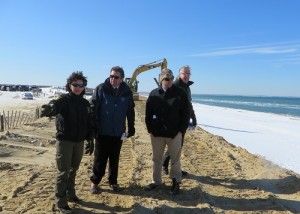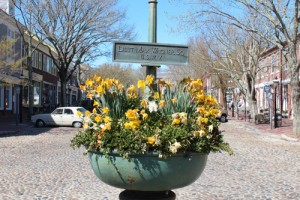
CCB MEDIA PHOTO
Officials gather at Sandy Neck Beach to see the results of recent storms. Sandy Neck Beach Park Manager Nina Coleman with Barnstable Town Manager Thomas Lynch, State Energy and Environmental Secretary Matthew Beaton and Barnstable Town Councilor Philip Wallace.
BARNSTABLE – Politicians and municipal officials in the towns of Sandwich and Barnstable hosted State Secretary of Energy and Environmental Affairs Matthew Beaton for a walk along the beach Friday.
But the walk was not a pleasure trip.
North-facing coastlines of both towns have suffered extreme erosion from storms this winter. Both towns are looking for permitting flexibility from state officials for emergency fixes for the erosion.
In Sandwich, storms transferred sand meant to bolster Town Neck Beach into a marsh, causing a potential flooding emergency. In Barnstable, severe erosion on Sandy Neck is now threatening the beach parking lot.
Christine Player, project manager with CLE Engineering out of Marion, the contractor hired by the town of Barnstable, said to Beaton, “One of the things it’s very important to recognize here is this is impacting infrastructure, existing infrastructure and it is within protected resource areas.”
Beaton said he will take the information back to Beacon Hill. “Now that we’re starting to see the regularity of these storms and the impact of these storms, there’s a little more of a sense of urgency about it,” he said.
Sandy Neck Beach Park Ranger Nina Coleman said Winter Storm Neptune on February 14 and 15 continued damage started by Winter Storm Juno from January 26 to 28 on Sandy Neck Beach.
The dunes fronting the parking lot have been all but leveled by the storms. Emergency sand nourishment put in place earlier this winter, what Coleman called “sacrificial” sand, has all been sacrificed to the sea. She said 100 percent of the sand placed on the beach as a buffeting measure is gone.
The town spend $119,000 on sacrificial sand in 2013 for 5,500 cubic yards. In 2014, the town spent $90,000 more on sand, at a for 4,300 cubic yards, for a total of $209,000 on sand.
Coleman is working on emergency funding of $50,000 for 2,600 cubic yards of sand to ensure the survival of the parking lot.
The next step, Coleman said is installing what is called “soft” engineering technology. The firm CLE has been contracted for design and permitting. The town is also exploring grant opportunities for the project, which is estimated to have a total cost of $400,000.
Player explained her desired short-term fix. “We’ve talked about actually putting in armor stone as the last line of defense, but then putting sand on top of it and planting on top of it. So when you look at that thing, it looks like a dune. But when you have a major storm event, there’s that line of defense. And then what do you do? You just put sand back on top of it as a maintenance approach” she said.
The final step, Coleman said, is “retreat,” that is, moving the parking lot back. The issue is that the land behind the parking lot is spadefoot toad habitat, an endangered species, she said.
By LAURA M. RECKFORD, CapeCod.com News Editor





















